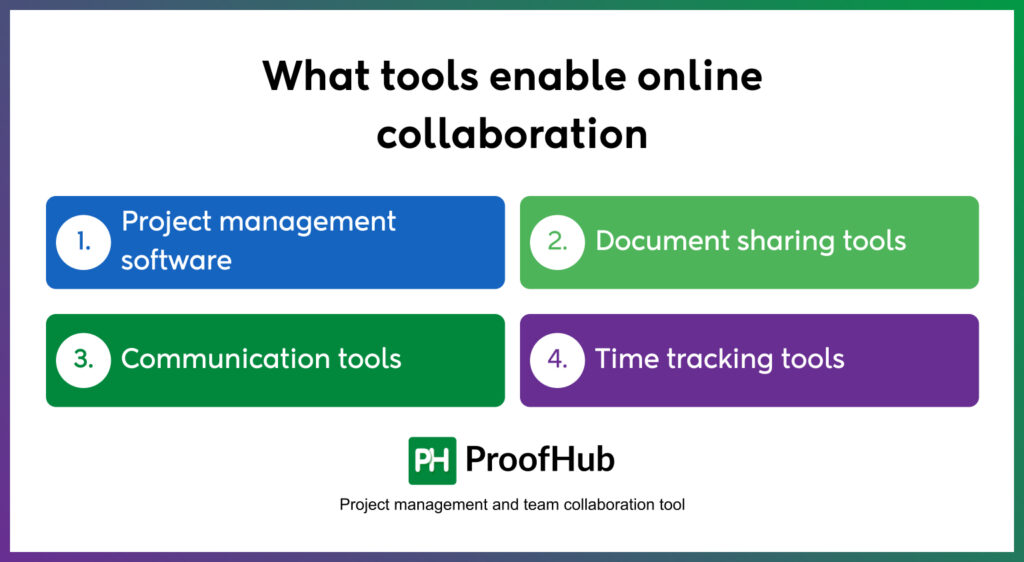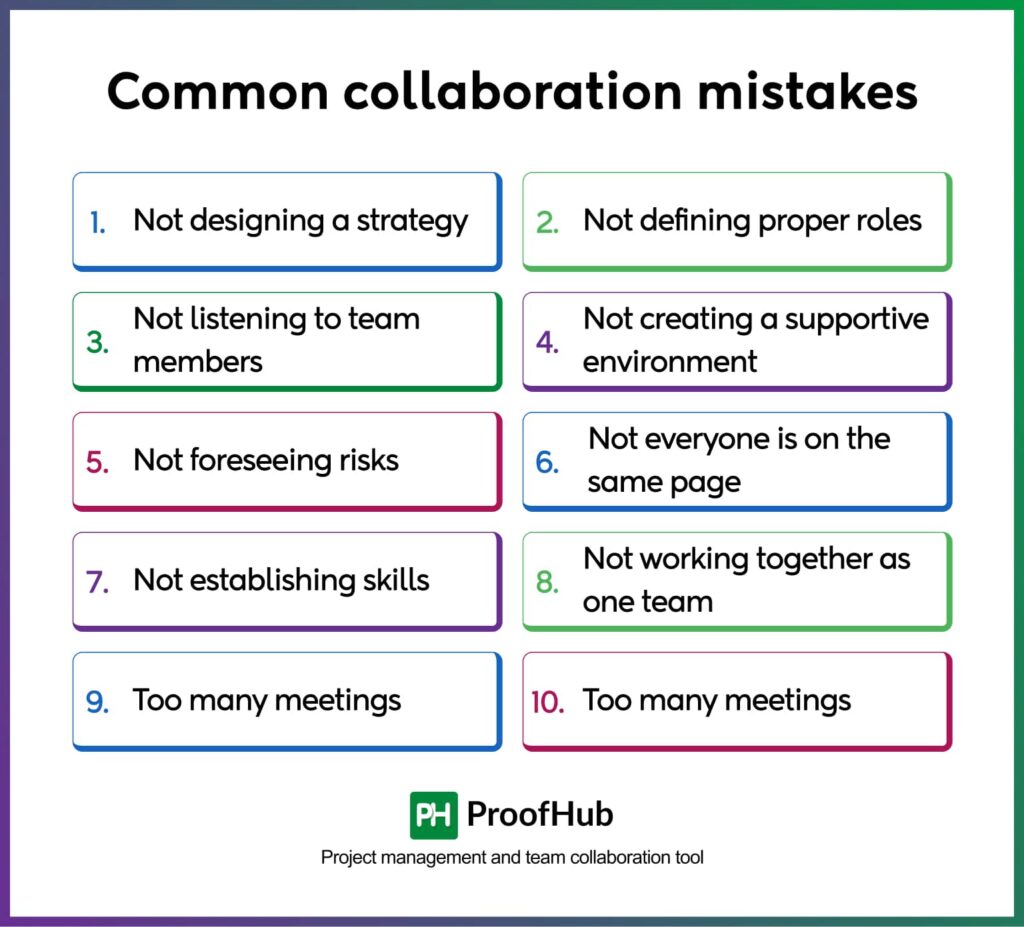Gone are the days when businesses took place just within a city or a country. Today, it is the age of the remote workforce, where people work and collaborate from different geographical locations.
We no longer have to be physically present in an office when we can seamlessly communicate with others, access documents and information from any device, and share feedback with just a click of the mouse from anywhere in the world.
Collaboration tools are indeed a big blessing in the 21st century. This being said, still many organizations are screwing up the collaboration part. According to reports, only 39% of teams reportedly complete projects on time. Around 60% of US workers consider effective communication their biggest roadblock to success.
In this article, we will discuss something in detail that has been neglected for the longest time: collaboration mistakes and how to avoid them. Before that, let’s understand the importance of online and offline collaboration.
Why is collaboration important?
The best things happen when people come together, share ideas, have discussions, and carry out work. Employee collaboration plays a crucial part in the following:
- Developing a common understanding of the whole project’s goals
- Setting the right expectations regarding who is supposed to do what
- Inculcating a sense of belonging and togetherness among employees
- Making sound decisions for the betterment of a project and organization
- Creating transparency and encouraging involvement from all team members
- Keeping the team informed, up-to-date, and synchronized
- Driving the business forward
- Contributing to a happier workforce
However, it is not always possible to have everyone around at the same place at the same time. That’s why many organizations rely on online collaboration to discuss, share, and make important decisions, even from different parts of the world.
Companies and businesses are making special efforts to create a collaborative environment. They are using online collaboration tools to enable seamless communication among employees and open new doors for collaboration.
What tools can help in online collaboration?
Luckily, many types of collaboration tools can be useful for a business, depending on your requirements and needs. Whether you work in an office or from your house, below are some online tools that facilitate solid collaboration.

- Project management software: When working with multiple people on multiple tasks, you need project management software offering advanced features and functionalities. Tools like ProofHub are one place for all your communications, documents, and projects. You can assign tasks, add deadlines, share documents, track time, make reports with such tools and collaborate better.
- Document sharing tools: With multiple documents being created, edited, shared, and collaborated over, it makes sense to have an effective document sharing tool by your side. The best part is that multiple people can update the same document simultaneously without any hassles.
- Communication tools: With a remote team, you can’t have daily meetings and standups to monitor project progress. However, communication tools like Google Hangouts and Skype are great options for teams to send messages and make video calls to quickly learn updates or have a quick conversation about how a project is shaping up.
- Time tracking tools: Time tracking tools let you and your team track work hours and see the visual breakdown of tracked time. They work across multiple devices. So, you can track time from your phone or desktop computer and continue online from any browser.
Common collaboration mistakes with their solutions

Professionals commit many collaboration mistakes, intentionally or unintentionally, daily. Let’s look at the following collaboration mistakes and their solutions.
1. Not designing a strategy
Many companies struggle with the problem of jumping into a project or task without doing a history check or defining a plan. A team needs to have a clear picture of what they will do in advance.
As per reports, a lack of clear goals is the most common factor (37%) behind project failure.
Solution: Before starting a project, you must design a clear strategy. If team members are clueless from the earliest stage of the process, things will go south sooner or later. It’s best to meet with stakeholders at the beginning to discuss expectations on cost, time, and product quality.
2. Not defining proper roles and responsibilities
One of the biggest collaboration mistakes you can commit is not clearly defining proper roles and responsibilities to team members. Project members must know how exactly a project will shape up and what is expected from them.
Solution: Once the strategy is devised, the next step is to define project members’ proper roles and responsibilities. This eliminates any miscommunication or confusion among team members, as project members know how to execute tasks to meet expectations in advance.
3. Not listening to team members
A true leader is someone who takes the team along, not the one who dictates to them what to do and where to go. If a project manager likes to operate in Hitler’s style, he is committing a serious collaboration mistake. Employee morale automatically drops down when a manager uses them as puppets.
Solution: Give autonomy to team members and listen to employees’ voices as they offer a lot of input, ideas, and suggestions. Every once in a while, let them make decisions—the bigger ones. It would encourage them and lift their spirits like nothing. Mind you, happy employees are the productive ones.
4. Not creating a supportive environment
It’s hard to teach a collaborative environment if it emphasizes individual performance, lacks trust within a company, and emphasizes competition. Moreover, company values, transparency, and flexibility are tremendous in sustaining a supportive, collaborative, and happier workspace.
Solution: As a project manager, your primary duty is to foster a collaborative environment. Employees should be able to voice their opinions and offer input without any second thoughts. When there is trust, mutual respect, and camaraderie in a workplace, employees generate more ideas and perform much better, with enhanced productivity.
5. Not foreseeing risks
Professionals aren’t meeting the expectation to identify and assess emerging risks due to a lack of collaboration within an organization. A survey conducted in 2016 concluded that risk professionals cited a lack of effective collaboration as the biggest roadblock in understanding the impact of emerging risks.
Solution: Risk committees should include voices from all over the organization to foster collaboration within your teams and tackle emerging risks. Discuss global and industry trends across an organization to discuss and share takeaways from various sources on emerging risks. Encourage employees to use data and analytics to identify, assess, and manage risks.
6. Not everyone is on the same page
Multiple people often work on the same tasks while handling complex results. If there’s an update or change in requirement, team members are not informed immediately, which leads to miscommunication and ineffective results. Understanding the skills and needs of team members in advance can avoid such problems.
Solution: First, make sure that roles are clearly defined and well-explained. It’s better to use online project management software like ProofHub, which shows people who is doing what and notifies them whenever an update is made. This helps team members collaborate effectively and produce better results.
7. Not establishing skills through employee training
It takes effort and a certain level of skill to be able to collaborate effectively. Some people aren’t that great with people and communication skills. Many admit to being hesitant or anxious even before giving an update or asking a question.
Solution: If you observe similar issues within your team, organize an enterprise training program for your team members. This will give them an opportunity to brush up on their communication skills and make them more skilled at using collaboration software and systems. When people are well-trained in advance, there is less chance of mistakes in collaboration, and they can take full advantage of their capabilities.
8. Not giving autonomy
While autonomy and collaboration might seem contradictory, in reality, both go hand in hand. Collaboration without independence often leads to a culture where people might not take personal accountability for their work. Autonomy without collaboration is quite like delivering good enough when you can provide something great with the help of others.
Solution: Offer several types of workspaces, as this is crucial for supporting both autonomy and collaboration. Often, employees have to switch from individual tasks to group tasks. Provide collaboration tools so that they can either work autonomously, collaborate with a team, or check in with their supervisor.
9. Not working together as one team
Internal conflicts and personal differences significantly affect workplace collaboration. Dislikeness, rivalry, ego, and office politics are some factors that prevent people from working together as one team. True collaboration happens when a bunch of people work together to achieve a shared goal, which means one has to rise above such pitiful things and work in proper harmony.
Solution: To be honest, it isn’t easy to work with employees who don’t get along, especially when they don’t agree. If you’re already aware of such dynamics in your workplace, it’s better to keep them engaged in different activities or groups.
10. Too many meetings
Focusing on work amidst too many meetings has almost become a challenge. Moreover, holding a relevant meeting has become difficult due to the following reasons:
- It’s hard to bring different people into one room owing to their different schedules
- Sharing a meeting agenda that attendees can relate to and contribute to
- Tracking progress from start to finish is nearly impossible following a meeting
Solution: Instead of holding too many meetings, reduce the number to just two weekly meetings. Make sure only relevant people take part in it. Define the purpose of the meeting in advance so that people come prepared rather than entirely clueless. If you’re not a fan of meetings, start using communication tools to enable the seamless exchange of relevant information.
“ProofHub is a proven team collaboration software that connects co-workers and helps them get work done faster. Check it out now!”
Collaboration tips to get your teams to communicate like pros
Below are some tips (in no particular order) that could help you foster collaboration within your team.
- Align everyone right from the beginning
- Allow team members to question and brainstorm in a non-judgmental setup
- Encourage transparency as it breeds trust and allows the teams to fix issues
- Pay attention to team dynamics to diffuse the tension among team members before it starts affecting the work environment
- Celebrate team successes and give a shout-out to individual team members for a job well done
- Avoid email to communicate. Use dedicated collaboration tools instead
- Keep meetings short and sweet if you can’t eliminate them
- The more frequent the communication, the better it is
- Make the work environment upbeat, happy, and productive
- Let your employees do what they need to do
- Focus on the metrics that matter and keep track of the overall progress
Conclusion
These tips will help you foster better collaboration and a better work environment, which could bring out the best in everyone. Not only does it make employees more productive, but it also makes them feel connected at work, leading to more employee happiness and satisfaction.

